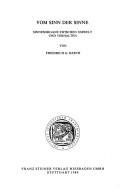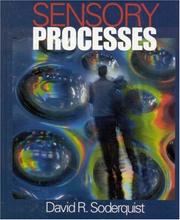| Listing 1 - 10 of 197 | << page >> |
Sort by
|
Book
Abstract | Keywords | Export | Availability | Bookmark
 Loading...
Loading...Choose an application
- Reference Manager
- EndNote
- RefWorks (Direct export to RefWorks)
Echolocation has evolved in different groups of animals, from bats and cetaceans to birds and humans, and enables localization and tracking of objects in a dynamic environment, where light levels may be very low or absent. Nature has shaped echolocation, an active sense that engages audiomotor feedback systems, which operates in diverse environments and situations. Echolocation production and perception vary across species, and signals are often adapted to the environment and task. In the last several decades, researchers have been studying the echolocation behavior of animals, both in the air and underwater, using different methodologies and perspectives. The result of these studies has led to rich knowledge on sound production mechanisms, directionality of the sound beam, signal design, echo reception and perception. Active control over echolocation signal production and the mechanisms for echo processing ultimately provide animals with an echoic scene or image of their surroundings. Sonar signal features directly influence the information available for the echolocating animal to perceive images of its environment. In many echolocating animals, the information processed through echoes elicits a reaction in motor systems, including adjustments in subsequent echolocation signals. We are interested in understanding how echolocating animals deal with different environments (e.g. clutter, light levels), tasks, distance to targets or objects, different prey types or other food sources, presence of conspecifics or certain predators, ambient and anthropogenic noise. In recent years, some researchers have presented new data on the origins of echolocation, which can provide a hint of its evolution. Theoreticians have addressed several issues that bear on echolocation systems, such as frequency or time resolution, target localization and beam-forming mechanisms. In this Research Topic we compiled recent work that elucidates how echolocation – from sound production, through echolocation signals to perception- has been shaped by nature functioning in different environments and situations. We strongly encouraged comparative approaches that would deepen our understanding of the processes comprising this active sense.
bats --- Biosonar --- Humans --- marine mammals --- sensory biology --- Birds --- Behavior --- Communication
Book
Abstract | Keywords | Export | Availability | Bookmark
 Loading...
Loading...Choose an application
- Reference Manager
- EndNote
- RefWorks (Direct export to RefWorks)
Echolocation has evolved in different groups of animals, from bats and cetaceans to birds and humans, and enables localization and tracking of objects in a dynamic environment, where light levels may be very low or absent. Nature has shaped echolocation, an active sense that engages audiomotor feedback systems, which operates in diverse environments and situations. Echolocation production and perception vary across species, and signals are often adapted to the environment and task. In the last several decades, researchers have been studying the echolocation behavior of animals, both in the air and underwater, using different methodologies and perspectives. The result of these studies has led to rich knowledge on sound production mechanisms, directionality of the sound beam, signal design, echo reception and perception. Active control over echolocation signal production and the mechanisms for echo processing ultimately provide animals with an echoic scene or image of their surroundings. Sonar signal features directly influence the information available for the echolocating animal to perceive images of its environment. In many echolocating animals, the information processed through echoes elicits a reaction in motor systems, including adjustments in subsequent echolocation signals. We are interested in understanding how echolocating animals deal with different environments (e.g. clutter, light levels), tasks, distance to targets or objects, different prey types or other food sources, presence of conspecifics or certain predators, ambient and anthropogenic noise. In recent years, some researchers have presented new data on the origins of echolocation, which can provide a hint of its evolution. Theoreticians have addressed several issues that bear on echolocation systems, such as frequency or time resolution, target localization and beam-forming mechanisms. In this Research Topic we compiled recent work that elucidates how echolocation – from sound production, through echolocation signals to perception- has been shaped by nature functioning in different environments and situations. We strongly encouraged comparative approaches that would deepen our understanding of the processes comprising this active sense.
bats --- Biosonar --- Humans --- marine mammals --- sensory biology --- Birds --- Behavior --- Communication
Book
Abstract | Keywords | Export | Availability | Bookmark
 Loading...
Loading...Choose an application
- Reference Manager
- EndNote
- RefWorks (Direct export to RefWorks)
Echolocation has evolved in different groups of animals, from bats and cetaceans to birds and humans, and enables localization and tracking of objects in a dynamic environment, where light levels may be very low or absent. Nature has shaped echolocation, an active sense that engages audiomotor feedback systems, which operates in diverse environments and situations. Echolocation production and perception vary across species, and signals are often adapted to the environment and task. In the last several decades, researchers have been studying the echolocation behavior of animals, both in the air and underwater, using different methodologies and perspectives. The result of these studies has led to rich knowledge on sound production mechanisms, directionality of the sound beam, signal design, echo reception and perception. Active control over echolocation signal production and the mechanisms for echo processing ultimately provide animals with an echoic scene or image of their surroundings. Sonar signal features directly influence the information available for the echolocating animal to perceive images of its environment. In many echolocating animals, the information processed through echoes elicits a reaction in motor systems, including adjustments in subsequent echolocation signals. We are interested in understanding how echolocating animals deal with different environments (e.g. clutter, light levels), tasks, distance to targets or objects, different prey types or other food sources, presence of conspecifics or certain predators, ambient and anthropogenic noise. In recent years, some researchers have presented new data on the origins of echolocation, which can provide a hint of its evolution. Theoreticians have addressed several issues that bear on echolocation systems, such as frequency or time resolution, target localization and beam-forming mechanisms. In this Research Topic we compiled recent work that elucidates how echolocation – from sound production, through echolocation signals to perception- has been shaped by nature functioning in different environments and situations. We strongly encouraged comparative approaches that would deepen our understanding of the processes comprising this active sense.
bats --- Biosonar --- Humans --- marine mammals --- sensory biology --- Birds --- Behavior --- Communication

ISBN: 128229752X 9786611733803 1281733806 1846427339 9786612297526 9781846427336 1843108712 9781843108719 9781843108719 9781843109150 6611733809 9781281733801 6612297522 Year: 2008 Publisher: London ; Philadelphia : Jessica Kingsley Publishers,
Abstract | Keywords | Export | Availability | Bookmark
 Loading...
Loading...Choose an application
- Reference Manager
- EndNote
- RefWorks (Direct export to RefWorks)
How do you feel when you bite into a pear… wear a feather boa… stand in a noisy auditorium… or look for a friend in a crowd?. It's likely that one of these situations would be pleasant for you, and perhaps one would be unpleasant. Some people will adore the grainy texture of a pear, while others will shudder at the idea of this texture in their mouths. Touching a feather boa will be fun and luxurious to some, and others will bristle at the idea of all those feathers brushing on the skin. Noisy, busy environments will energize some people, and will overwhelm others. These d
Senses and sensation. --- Sensation --- Sensory biology --- Sensory systems --- Knowledge, Theory of --- Neurophysiology --- Psychophysiology --- Perception
Book
ISBN: 9027258902 9027209804 Year: 2021 Publisher: Amsterdam, Netherlands ; Philadelphia, Pennsylvania : John Benjamins Publishing Company,
Abstract | Keywords | Export | Availability | Bookmark
 Loading...
Loading...Choose an application
- Reference Manager
- EndNote
- RefWorks (Direct export to RefWorks)
"Sensory Experiences: Exploring meaning and the senses describes the collective elaboration of a situated cognitive approach with an emphasis on the relations between language and cognition within and across different sensory modalities and practices. This approach, grounded in 40 years of empirical research, is a departure from the analytic, reductive view of human experiences as information processing. The book is structured into two parts. Each author first introduces the situated cognitive approach from their respective sensory domains (vision, audition, olfaction, gustation). The second part is the collective effort to derive methodological guidelines respecting the ecological validity of experimental investigations while formulating operational answers to applied questions (such as the sensory quality of environments and product design). This book will be of interest to students, researchers and practitioners dealing with sensory experiences and anyone who wants to understand and celebrate the cultural diversity of human productions that make life enjoyable!"--
Senses and sensation. --- Cognition. --- Psychology --- Sensation --- Sensory biology --- Sensory systems --- Knowledge, Theory of --- Neurophysiology --- Psychophysiology --- Perception

ISBN: 3515053840 9783515053846 Year: 1989 Volume: 25/1 Publisher: Wiesbaden Steiner
Abstract | Keywords | Export | Availability | Bookmark
 Loading...
Loading...Choose an application
- Reference Manager
- EndNote
- RefWorks (Direct export to RefWorks)
Senses and sensation. --- Senses and sensation --- Sensation --- Sensory biology --- Sensory systems --- Knowledge, Theory of --- Neurophysiology --- Psychophysiology --- Perception

ISBN: 0226709280 Year: 1970 Publisher: Chicago (Ill.) : University of Chicago press,
Abstract | Keywords | Export | Availability | Bookmark
 Loading...
Loading...Choose an application
- Reference Manager
- EndNote
- RefWorks (Direct export to RefWorks)
Philosophy --- Senses and sensation --- Sensation --- Sensory biology --- Sensory systems --- Knowledge, Theory of --- Neurophysiology --- Psychophysiology --- Perception --- Mental philosophy --- Humanities --- Philosophy.
Book
ISBN: 9782875620521 2875620525 Year: 2014 Publisher: Liège Presses Universitaires de Liège
Abstract | Keywords | Export | Availability | Bookmark
 Loading...
Loading...Choose an application
- Reference Manager
- EndNote
- RefWorks (Direct export to RefWorks)
Senses and sensation. --- Sensation --- Sensory biology --- Sensory systems --- Knowledge, Theory of --- Neurophysiology --- Psychophysiology --- Perception --- Senses and sensation
Book
ISBN: 1280595345 9786613625175 0199780722 9780199780723 9780195385977 0195385977 9780195385960 0195385969 Year: 2011 Publisher: Oxford ; New York : Oxford University Press,
Abstract | Keywords | Export | Availability | Bookmark
 Loading...
Loading...Choose an application
- Reference Manager
- EndNote
- RefWorks (Direct export to RefWorks)
The senses, or sensory modalities, constitute the different ways we have of perceiving the world, such as seeing, hearing, touching, tasting and smelling. But how many senses are there? How many could there be? What makes the senses different? What interaction takes place between the senses? This book is a guide to thinking about these questions. Together with an extensive introduction to the topic, the book contains the key classic papers on this subject together with nine newly commissioned essays.One reason that these questions are important is that we are receiving a huge influx of new inf
Senses and sensation. --- Sense (Philosophy) --- Philosophy --- Senses and sensation --- Sensation --- Sensory biology --- Sensory systems --- Knowledge, Theory of --- Neurophysiology --- Psychophysiology --- Perception

ISBN: 132230663X 1452262837 9781452262833 9781452229515 1452229511 0761923330 9780761923336 Year: 2002 Publisher: Thousand Oaks, Calif. ; London : SAGE,
Abstract | Keywords | Export | Availability | Bookmark
 Loading...
Loading...Choose an application
- Reference Manager
- EndNote
- RefWorks (Direct export to RefWorks)
Emphasising the underlying neural structures and functions of sensory systems, this book presents complex material at a level comprehensible to undergraduates as well as beginning graduate students.
Senses and sensation. --- Nervous system. --- Sensation --- Sensory biology --- Sensory systems --- Knowledge, Theory of --- Neurophysiology --- Psychophysiology --- Perception --- Organs (Anatomy) --- Neurosciences
| Listing 1 - 10 of 197 | << page >> |
Sort by
|

 Search
Search Feedback
Feedback About
About Help
Help News
News